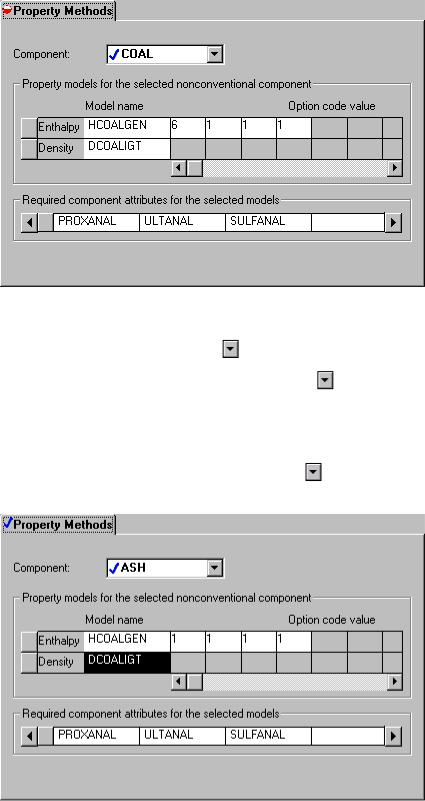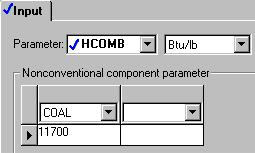
- •Contents
- •About Getting Started Modeling Processes with Solids
- •Why Use Solids Simulation?
- •Sessions in this Book
- •Using Backup Files
- •Related Documentation
- •Installation Manual
- •User Guide
- •Technical Support
- •World Wide Web
- •Hours
- •Modeling Coal Drying
- •Coal Drying Flowsheet
- •Drawing the Graphical Simulation Flowsheet
- •Stream Classes and Substreams
- •Specifying Components
- •Defining Properties
- •For More Information on the HCOALGEN Model
- •Entering Stream Data
- •Specifying Blocks
- •Using a Calculator Block to Control Drying
- •Running the Simulation
- •Examining Simulation Results
- •Exiting Aspen Plus
- •Modeling Coal Combustion
- •Coal Combustion Flowsheet
- •Starting Aspen Plus
- •Opening an Existing Run
- •If Your Saved File Solid1.apw is Not Displayed
- •Saving a Run Under a New Name
- •Drawing the Graphical Simulation Flowsheet
- •Changing the Stream Class
- •Adding Components to the Model
- •Defining Properties
- •Change the Heat of Combustion Method for Coal
- •Specify the Heat of Combustion for Coal
- •Specifying the Air Stream
- •Specifying Unit Operation Models
- •Specify the Splits for the SSplit Block
- •Defining a Calculator Block
- •Specify the Calculations to be Performed
- •Specify When the Calculator Block Should be Run
- •Running the Simulation
- •Examining Results
- •Exiting Aspen Plus
- •Modeling Gas-Solid Separators
- •Gas-Solid Separation Flowsheet
- •Starting Aspen Plus
- •Opening an Existing Run
- •If Your Saved File Solid2.apw is Not Displayed
- •Saving a Run Under a New Name
- •Drawing the Graphical Simulation Flowsheet
- •To Update the Title for This Simulation
- •Running the Simulation
- •Examining Results
- •Exiting Aspen Plus
- •Modeling Polymer Recovery
- •Polymer Recovery Flowsheet
- •Starting Aspen Plus
- •To Specify the Application Type and Run Type for the New Run
- •Drawing the Graphical Simulation Flowsheet
- •Specifying Components
- •Defining Properties
- •Defining Stream Conditions
- •Entering Block Specifications
- •Enter Specifications for the CCD Model
- •To Learn More about the Cyclone Model Using Help
- •Enter Specifications for the Cyclone Model
- •To Specify That the Mixer Block DRIER Operates at 15 psi
- •Enter Specifications for the HyCyc Model
- •Running the Simulation
- •Examining Results
- •Exiting Aspen Plus
- •Connecting to the Aspen Plus Simulation Engine
Change the Heat of Combustion Method for Coal
Note that you assigned Carbon a Type of Solid. Specifying a component type of Solid allows that component to be placed in the CIPSD substream.
3Click  to continue.
to continue.
The Properties | Advanced | NC Props | Property Methods sheet appears.
Defining Properties
Use the Properties | Advanced | NC Props | Property Methods sheet to specify the models used to calculate the nonconventional solid properties. In Simulation 1, Aspen Plus estimates the heat of coal combustion based on its PROXANAL, ULTANAL, and SULFANAL. In this simulation, enter the heat of combustion directly.
1In the Component field, click  and select COAL.
and select COAL.
2In the toolbar, click  .
.
3Click the HCOALGEN Model name.
4Click the Coal Enthalpy link.
5In the help window that appears, scroll down to the table
HCOALGEN Option Codes.
The help screen indicates that the first option code defines how Aspen Plus calculates the heat of combustion. Aspen Plus has six methods for calculating the heat of combustion. Use the sixth method, User input value.
6Close the help window.
Getting Started - Solids |
Modeling Coal Combustion • 3-7 |

7Change the first HCOALGEN Option code value field from 1 to 6.
Specify Methods for You must also specify how Aspen Plus calculates the enthalpy and
Calculating Ash |
density of ASH. |
|
|
|
Properties |
8 |
In the Component field, click |
and select ASH. |
|
|
||||
|
9 |
In the Model name field for Enthalpy, click |
and select |
|
|
|
HCOALGEN. |
|
|
|
|
The Option code value defaults of 1, 1, 1, and 1 are acceptable |
||
|
|
for ASH. |
|
|
|
10 |
In the Model name field for Density, click |
and select |
|
|
|
DCOALIGT. |
|
|
3-8 • Modeling Coal Combustion |
Getting Started - Solids |

Specify the Heat of Combustion for Coal
You just specified that Aspen Plus will use a user-specified value for the heat of combustion of coal. Now you must specify that value.
11From the Data Browser, select the Properties | Parameters |
Pure Component folder.
The Properties | Parameters | Pure Component object manager appears.
12Click New.
The New Pure Component Parameters dialog box appears. The heat of combustion for coal is a Nonconventional type.
13Select the Nonconventional option at the top.
14Enter HEAT as the new name at the bottom.
15Click OK.
The Properties | Parameters | Pure Component | HEAT | Input sheet appears.
16In the Parameter field, click  and select HCOMB.
and select HCOMB.
Note that the prompt indicates that HCOMB is the heat of combustion on a dry basis. Use the following equation to convert the heat of combustion on a wet basis to a dry basis:
HCOMB = Heat of Combustion (wet) * |
100 |
100 − % Moisture |
17In the first line under the Nonconventional component parameter column, click  and select COAL.
and select COAL.
18In the parameter value field directly below COAL, enter the heat of combustion on a dry basis: 11700 Btu/lb.
19Click  to continue.
to continue.
The Required Properties Input Complete dialog box appears.
20Click OK to access the next required input sheet.
Getting Started - Solids |
Modeling Coal Combustion • 3-9 |
